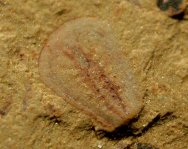Primicaris larvaformis
Phylum Arthropoda
Geological Time: Early Cambrian (~525 million years ago)
Size: Primicaris fossil is 4 mm long by 2 mm wide
Fossil Site: Chengjiang Maotianshan Shales - Quiongzhusi Section, Yu’anshan Member, Heilinpu Formation, Mafang Village, Anning, Kunming, Yunnan Province, China
|
To complicate things even more, Primicaris is extremely close in appearance to the putative Ediacaran arthropod Parvancorina, as well as the early Protaspid development stage of some Cambrian Redlichia trilobites. All this said, it is straightforward to hypothesize a phylogeny from the unsegmented Parvancorina, to Primicaris with its apparently nascent cephalon, to Naraoia with clearly differentiated cephalon, to the Helmetids (Kuamaia, Skioldia, or Panlongia) with undisputed cephalon, thorax, and pygidium, and finally to the early Cambrian Redlichlia trilobites with their truly distinct cephalon, thorax, pygidial segmentation and other trilobite-like traits. Of course, such a phylogeny (ancestral path) would make Parvancorina (or a very similar animal) an ancient ancestor of all the trilobites, and at least potentially, Primicaris the oldest trilobite relative in the early Cambrian fossil record.
Also see: Chengjiang Biota Relatives and Ancestors of Trilobites Chengjiang Fossils Cambrian Explosion |
||||||||||||






